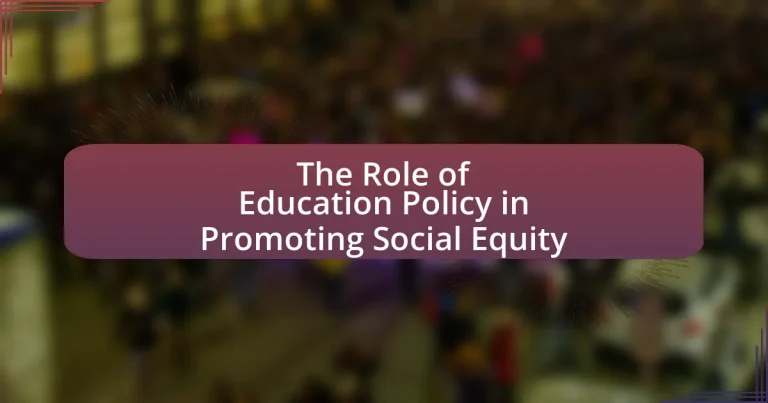Education policy is a critical mechanism for promoting social equity by ensuring equal access to quality education for individuals from diverse socioeconomic backgrounds. This article examines how education policies, such as equitable funding, inclusive curricula, and targeted support for marginalized groups, influence educational outcomes and social mobility. It highlights key components of education policy that affect social equity, the historical context shaping current policies, and the roles of various stakeholders in advocating for equitable education. Additionally, the article discusses successful examples of policies that have improved social equity and outlines practical steps educators can take to support these initiatives within existing frameworks.

What is the Role of Education Policy in Promoting Social Equity?
Education policy plays a crucial role in promoting social equity by establishing frameworks that ensure equal access to quality education for all individuals, regardless of their socioeconomic background. These policies aim to reduce disparities in educational resources, funding, and opportunities, thereby fostering an inclusive environment that supports marginalized groups. For instance, the implementation of Title I of the Elementary and Secondary Education Act in the United States allocates federal funds to schools serving low-income students, directly addressing educational inequities. Research indicates that equitable education policies can lead to improved academic outcomes and increased social mobility, as evidenced by studies showing that students from disadvantaged backgrounds perform better in well-funded, supportive educational settings.
How does education policy influence social equity?
Education policy significantly influences social equity by determining access to quality education and resources for diverse populations. Policies that promote equitable funding, inclusive curricula, and support for marginalized groups can reduce disparities in educational outcomes. For instance, the implementation of Title I funding in the United States aims to provide additional resources to schools serving low-income students, which has been shown to improve academic performance and close achievement gaps. Furthermore, education policies that emphasize early childhood education and support for English language learners can enhance opportunities for disadvantaged communities, fostering greater social equity over time.
What are the key components of education policy that affect social equity?
Key components of education policy that affect social equity include funding allocation, curriculum standards, teacher training, and access to resources. Funding allocation determines the financial support available to schools, which directly impacts the quality of education provided, particularly in low-income areas. For instance, research by the Education Trust shows that schools serving predominantly low-income students receive significantly less funding than those serving wealthier populations. Curriculum standards ensure that all students receive a consistent and equitable education, while teacher training programs are essential for equipping educators with the skills to address diverse student needs. Access to resources, such as technology and extracurricular programs, further influences educational outcomes and opportunities for all students, thereby promoting social equity.
How do these components interact to promote or hinder social equity?
Education policy components, such as funding allocation, curriculum design, and access to resources, interact to either promote or hinder social equity. For instance, equitable funding models that allocate resources based on student needs can enhance educational opportunities for marginalized groups, thereby promoting social equity. Conversely, policies that favor affluent districts can exacerbate disparities, limiting access to quality education for underprivileged communities. Research indicates that states with more equitable funding formulas see improved outcomes for low-income students, highlighting the critical role of funding in fostering social equity.
Why is social equity important in education?
Social equity is important in education because it ensures that all students have equal access to quality educational resources and opportunities, regardless of their background. This principle promotes fairness and addresses systemic inequalities that can hinder academic achievement. Research indicates that equitable education leads to improved outcomes for marginalized groups, as evidenced by studies showing that schools with inclusive policies see higher graduation rates and better overall student performance. For instance, the National Center for Education Statistics reports that equitable funding and resource allocation significantly enhance educational attainment among disadvantaged populations.
What are the consequences of inequity in education?
Inequity in education leads to significant disparities in academic achievement and future opportunities. Students from underfunded schools often experience lower graduation rates, reduced access to advanced coursework, and limited resources, which can hinder their academic performance. For instance, a report by the National Center for Education Statistics indicates that schools in low-income areas receive about $1,200 less per student than those in affluent neighborhoods. This funding gap contributes to a cycle of poverty, as individuals with lower educational attainment typically face challenges in securing well-paying jobs, thereby perpetuating socioeconomic disparities. Additionally, inequity in education can result in social unrest and decreased civic engagement, as marginalized groups may feel disenfranchised and excluded from societal benefits.
How does social equity contribute to overall societal well-being?
Social equity enhances overall societal well-being by ensuring that all individuals have fair access to resources, opportunities, and rights, which fosters social cohesion and stability. When social equity is prioritized, marginalized groups experience improved educational outcomes, better health, and increased economic participation, leading to a more productive society. For instance, research by the National Equity Project indicates that equitable education policies can reduce achievement gaps, resulting in higher graduation rates and better job prospects for disadvantaged students. This, in turn, contributes to lower crime rates and improved public health, demonstrating that social equity is integral to a thriving society.
What historical context shapes current education policies related to social equity?
Current education policies related to social equity are shaped by historical contexts such as the Civil Rights Movement, which aimed to dismantle systemic racism and promote equal access to education. Landmark legislation like the Elementary and Secondary Education Act of 1965 was enacted to address educational disparities, providing federal funding to schools serving low-income students. Additionally, the Supreme Court’s decision in Brown v. Board of Education (1954) declared racial segregation in public schools unconstitutional, setting a precedent for future policies aimed at ensuring equitable educational opportunities. These historical events have laid the foundation for ongoing efforts to address inequities in education, influencing contemporary policy frameworks that prioritize inclusivity and access for marginalized groups.
What major legislation has influenced education policy in relation to social equity?
The major legislation that has influenced education policy in relation to social equity is the Elementary and Secondary Education Act (ESEA) of 1965. This act aimed to close the educational achievement gap by providing federal funding to schools serving low-income students, thereby promoting equal access to quality education. The ESEA has undergone several reauthorizations, including the No Child Left Behind Act of 2001 and the Every Student Succeeds Act of 2015, which continued to emphasize accountability and support for disadvantaged populations. These legislative measures have been pivotal in shaping policies that address disparities in educational resources and outcomes, reinforcing the commitment to social equity in education.
How have historical inequalities impacted present-day education policies?
Historical inequalities have significantly shaped present-day education policies by perpetuating systemic disparities in access and quality of education. For instance, the legacy of segregation in the United States has led to ongoing funding inequities, where schools in predominantly minority neighborhoods receive less financial support compared to those in affluent areas. According to the U.S. Department of Education, schools serving low-income students often have fewer resources, less experienced teachers, and inadequate facilities, which directly affects educational outcomes. Additionally, policies such as affirmative action and targeted funding initiatives have emerged as responses to these historical injustices, aiming to level the playing field and promote equity in education. These measures reflect an acknowledgment of past inequalities and a commitment to addressing their lasting impacts on educational access and achievement.
How do different stakeholders influence education policy for social equity?
Different stakeholders influence education policy for social equity through advocacy, funding, and research. Policymakers, educators, parents, and community organizations collaborate to shape policies that address disparities in educational access and resources. For instance, research by the National Education Association indicates that teacher unions advocate for equitable funding and resources, which directly impacts policy decisions at local and state levels. Additionally, community organizations often mobilize grassroots efforts to highlight inequities, pushing for reforms that promote social equity in education. These collective actions create a framework for policies that aim to reduce educational disparities and enhance opportunities for marginalized groups.
What roles do government, educators, and communities play in shaping these policies?
Government, educators, and communities play crucial roles in shaping education policies that promote social equity. Governments establish the legal and funding frameworks that dictate educational standards and access, ensuring that resources are allocated to underserved populations. Educators implement these policies in classrooms, adapting curricula to meet diverse student needs and advocating for equitable practices. Communities contribute by voicing local concerns and needs, influencing policy decisions through engagement and collaboration with schools and government entities. For instance, the Every Student Succeeds Act (ESSA) emphasizes local control and community involvement in education, highlighting the importance of these stakeholders in creating equitable educational environments.
How can advocacy groups affect changes in education policy?
Advocacy groups can affect changes in education policy by mobilizing public opinion, influencing legislators, and providing research-based evidence to support their positions. These organizations often engage in grassroots campaigns, leveraging community support to raise awareness about specific educational issues, which can lead to increased pressure on policymakers. For instance, the American Civil Liberties Union (ACLU) has successfully advocated for policies that promote equitable access to education, demonstrating the impact of organized efforts on legislative outcomes. Additionally, advocacy groups frequently collaborate with researchers to produce studies that highlight disparities in education, thereby equipping policymakers with the necessary data to justify reforms aimed at promoting social equity.
What are the challenges in implementing education policies aimed at promoting social equity?
Implementing education policies aimed at promoting social equity faces several challenges, including funding disparities, resistance to change, and systemic inequalities. Funding disparities often result in unequal resource allocation, where schools in low-income areas receive less financial support, hindering their ability to provide quality education. Resistance to change can stem from various stakeholders, including educators and policymakers, who may be reluctant to adopt new practices or curricula that challenge the status quo. Additionally, systemic inequalities, such as those based on race, socioeconomic status, and geographic location, create barriers that policies must address to be effective. For instance, a report by the National Center for Education Statistics highlights that schools serving predominantly minority students often have fewer experienced teachers and less access to advanced coursework, illustrating the impact of these systemic issues on educational equity.
What barriers do policymakers face in achieving social equity through education?
Policymakers face several barriers in achieving social equity through education, including funding disparities, systemic biases, and lack of community engagement. Funding disparities arise from unequal distribution of resources, where schools in affluent areas receive more financial support compared to those in low-income neighborhoods, leading to significant differences in educational quality. Systemic biases, such as racial and socioeconomic discrimination, can hinder equitable access to educational opportunities, perpetuating existing inequalities. Additionally, lack of community engagement often results in policies that do not reflect the needs and voices of marginalized groups, further complicating efforts to create an equitable educational landscape. These barriers collectively impede the effectiveness of education policies aimed at promoting social equity.
How do socioeconomic factors complicate the implementation of equitable education policies?
Socioeconomic factors complicate the implementation of equitable education policies by creating disparities in access to resources, opportunities, and support systems. For instance, students from low-income families often attend underfunded schools that lack essential materials, experienced teachers, and extracurricular programs, which hinders their academic performance and overall development. According to the National Center for Education Statistics, schools in high-poverty areas receive significantly less funding per student compared to those in affluent neighborhoods, exacerbating educational inequities. Additionally, socioeconomic status influences parental involvement, with lower-income parents facing barriers such as time constraints and lack of access to information, further impacting their children’s educational outcomes. These factors collectively create a cycle of disadvantage that makes it challenging to implement policies aimed at achieving educational equity.
What successful examples exist of education policies promoting social equity?
Successful examples of education policies promoting social equity include the implementation of universal pre-kindergarten programs and targeted funding for low-income schools. Universal pre-kindergarten programs, such as those in New York City, have been shown to increase school readiness among disadvantaged children, leading to improved long-term educational outcomes. Additionally, targeted funding initiatives, like the Title I program in the United States, allocate resources specifically to schools serving low-income students, resulting in enhanced educational opportunities and reduced achievement gaps. These policies demonstrate measurable impacts on student performance and access to quality education, reinforcing their effectiveness in promoting social equity.
What specific programs have shown measurable improvements in social equity?
Programs such as the Harlem Children’s Zone and the Chicago Public Schools’ “Grow Your Own” initiative have shown measurable improvements in social equity. The Harlem Children’s Zone, which provides comprehensive support services to children and families in a 97-block area of Harlem, has reported significant increases in educational attainment and college enrollment rates among participants. Similarly, the “Grow Your Own” initiative in Chicago focuses on training local residents to become teachers, resulting in a more diverse teaching workforce and improved student performance in under-resourced schools. These programs demonstrate how targeted educational policies can effectively address disparities and promote social equity.
How can these successful examples be replicated in other contexts?
Successful examples of education policies promoting social equity can be replicated in other contexts by adapting their core principles to local needs and conditions. For instance, policies that prioritize equitable funding for schools, such as those implemented in Finland, can be tailored to address specific socioeconomic disparities in different regions. Research shows that equitable funding leads to improved educational outcomes, as evidenced by the increased graduation rates in areas that adopted similar funding models. Additionally, fostering community involvement in education, as seen in successful programs in Canada, can enhance local engagement and support, making it easier to implement similar initiatives elsewhere. By analyzing the successful elements of these policies and aligning them with the unique challenges of different communities, stakeholders can effectively replicate their success in promoting social equity through education.
How can education policy be improved to better promote social equity?
Education policy can be improved to better promote social equity by implementing targeted funding strategies that allocate resources based on student needs rather than equal distribution. Research indicates that schools in low-income areas often lack adequate funding, which directly impacts educational outcomes; for example, the Education Trust found that schools serving predominantly students of color receive $23 billion less in funding than those serving mostly white students. Additionally, policies should focus on inclusive curricula that reflect diverse histories and cultures, fostering a sense of belonging among all students. Evidence from the National Education Association shows that culturally relevant teaching improves engagement and achievement for marginalized groups. Finally, enhancing access to early childhood education programs can bridge gaps before formal schooling begins, as studies from the National Institute for Early Education Research demonstrate that such programs significantly improve long-term academic success for disadvantaged children.
What best practices should be adopted in policy formulation?
Best practices in policy formulation include stakeholder engagement, evidence-based decision-making, and iterative evaluation. Stakeholder engagement ensures that diverse perspectives are considered, which enhances the relevance and acceptance of policies. Evidence-based decision-making relies on data and research to inform policy choices, leading to more effective outcomes. Iterative evaluation allows for continuous improvement by assessing the impact of policies and making necessary adjustments. For instance, the OECD’s “Education at a Glance” report emphasizes the importance of data-driven policies in improving educational outcomes and promoting equity.
How can ongoing assessment and feedback improve education policies for social equity?
Ongoing assessment and feedback can significantly improve education policies for social equity by providing data-driven insights that identify disparities in student performance and resource allocation. This continuous evaluation allows policymakers to adjust strategies in real-time, ensuring that interventions are effectively addressing the needs of marginalized groups. For instance, research from the National Center for Education Statistics indicates that schools implementing regular assessments can better track achievement gaps and tailor support services, leading to improved outcomes for underrepresented students. By utilizing feedback mechanisms, education policies can be refined to promote equitable access to quality education, thereby fostering a more inclusive learning environment.
What practical steps can educators take to support social equity within existing policies?
Educators can support social equity within existing policies by implementing inclusive teaching practices and advocating for equitable resource allocation. Inclusive teaching practices involve adapting curricula to reflect diverse perspectives and ensuring that all students feel represented and valued in the classroom. For instance, research shows that culturally relevant pedagogy enhances student engagement and achievement among marginalized groups. Additionally, educators can advocate for equitable resource allocation by collaborating with school administrators to identify and address disparities in funding, access to technology, and extracurricular opportunities. Studies indicate that schools with equitable resource distribution see improved academic outcomes for all students, particularly those from disadvantaged backgrounds.





